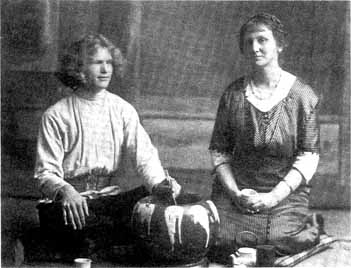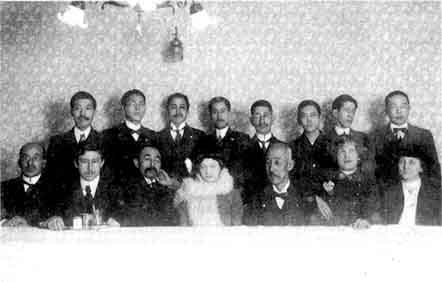
|
Traces That Remain:
A Pictorial History of the Early Days of the Bahá'í Faith among the Japanese
by Barbara R. Sims
edited by Sheridan Sims  |
chapter 20 | start page | single page | chapter 22 |  |
Chapter 21

click here for larger image
Miss Alexander and Vasily Eroshenko, a blind Russian Esperantist, who lived for a time in Tokyo. He did the first translation of the "Hidden Words of Bahá'u'lláh" (Arabic section), into Esperanto in 1916. He helped Miss Alexander learn both English and Esperanto Braille, and he introduced her to many people, including Mr. Torii. Mr. Eroshenko was greatly attracted to the Faith at the time. Later he left Japan and returned to Russia, and, according to Miss Alexander, he lost the inspiration he had received through the Bahá'í Teachings. This photograph was taken in 1915.
Mr. Torii, Mr. Kenjiro Ono and Mr. Tomonaga Noto all wrote to 'Abdu'l-Bahá. The blind were shown great love by Him. Five of His eighteen Tablets to Japanese were addressed to the blind; two to Mr. Torii, two to Mr. Ono and one to Mr. Noto.
Miss Alexander continued to have many opportunities through the years to meet the blind and attend their meetings.

Miss Alexander and Mr. Kenjiro Ono. He was the first blind man to study in a university in Japan (1914). He was greatly attracted to the Faith, and he helped Miss Mochizuki start the first Bahá'í magazine in Japanese, "Higashi no Hoshi," but he did not commit himself to the Faith.'Abdu'l-Bahá wrote to him, "Verily, verily thou hast suffered much in thy life time. Praise be unto God, that thy insight is keen. Do not thou lament over thy poverty, for the Treasury of the Kingdom is thine...".
'Abdu'l-Bahá offered him great confirmations, "Rest assured that thou wilt be confirmed to give sight to the blind and hearing power to the deaf and even thou wilt give life to the dead!"
However, Mr. Ono soon left Japan to join Eroshenko in China and Russia, and he died abroad. The man on the right is thought to be Mr. Sanzo Misawa, one of the early Bahá'ís. This photograph was taken about 1916.
This photograph was dated March 31, 1915. Miss Alexander is sitting at the far right, and Mr. Eroshenko next to her. It is apparently an Esperanto group.
Mr. Keiji Sawada, who was blind, is shown being greeted by Miss Helen Keller when she came to Japan in 1937. Mr. Sawada was listed as being on the first Local Spiritual Assembly of Tokyo in 1932. He and his wife were close friends of Miss Alexander, and he associated with Bahá'ís when he went to the United States for study. He did not identify himself as a Bahá'í in later years although he and his wife can be seen in photographs taken at Bahá'í activities in the years after the war.

click here for larger image
Mr. Torii is speaking before the Blind Association, on the occasion of Miss Keller's visit to Japan. She is sitting second from the right. Miss Keller was well aware of the Faith and wrote appreciatively of it.Miss Keller was born blind and deaf. Her life, overcoming all difficulties and rising to eminence in the world, has been an inspiration to all, not only similarly affected people. She was given much publicity when she came to Japan. The first time happened to be during one of Martha Root's trips, but apparently they did not meet. Miss Root, always the journalist, circulated to the Japanese newspapers Miss Keller's words about the Bahá'í Faith, "The philosophy of Bahá'u'lláh deserves the best thought we can give it ... what nobler theme than the 'good of the world and the happiness of the nations' can occupy our lives? ..." Miss Keller came again to Japan in 1955 and met Mr. Torii and Mr. Sawada at the schools for the blind where they were teaching.
 |
chapter 20 | start page | single page | chapter 22 |  |
|
|

